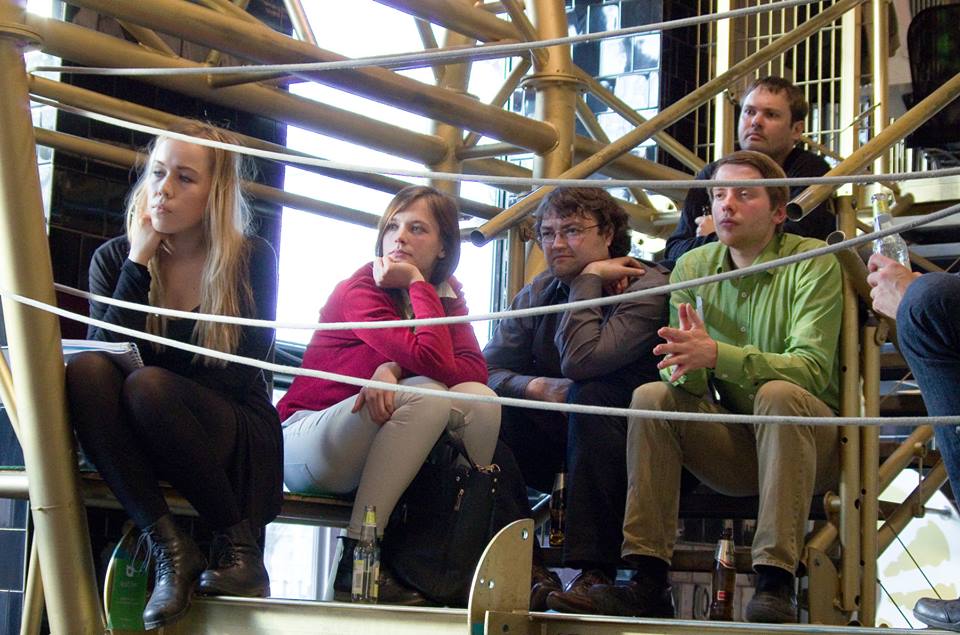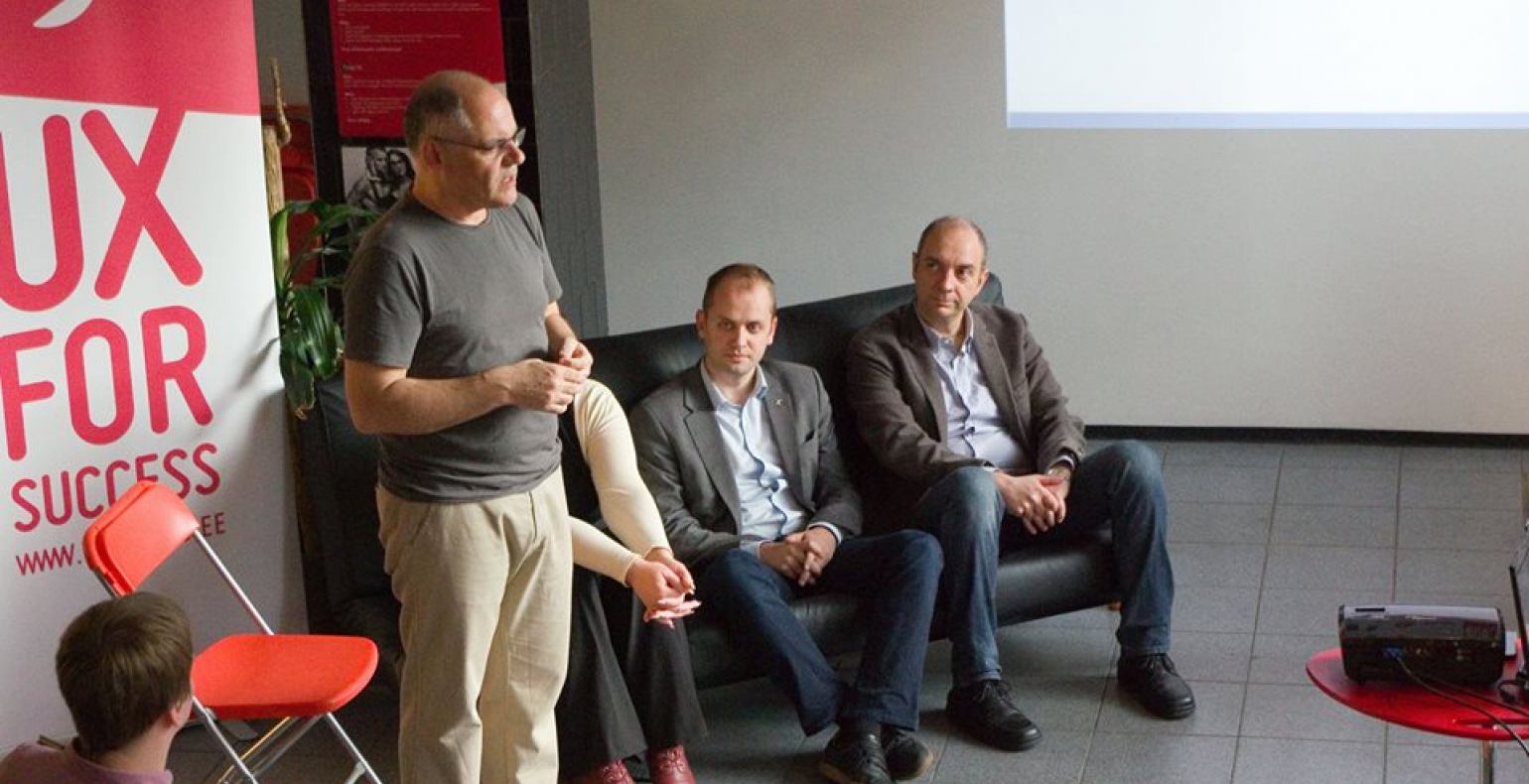Summary of the 2nd EstCHI Meetup in Tallinn
Last week we held our second EstCHI meetup. Despite the late announcement we again had a full house of people from nearly all fields – from developers to designers to government officials, and IxD students.
This time we had a panel with participants from both the industry and academia with an aim of bringing the two closer together. This proved to be a good idea as it spawned some very interesting topics. The presentation itself is available here.
David Lamas kicked off the event with a short introduction to EstCHI
In David`s words: “EstCHI is a tiny part of ACM (Association for Computing Machinery) the largest and oldest computing association in the industry, and inside ACM there lies a variety of different Special Interest Groups or SIGs for short
One of those SIGs is SIGCHI, the Special Interest Group of Computer-Human Interaction out of which EstCHI is the Estonian branch. EstCHI got started in 2011 and is currently run by volunteers mostly from Tallinn University and Trinidad Consulting. EstCHI is also the driving force behind the WUD Tallinn conference coming up on 13-14th of November.”
Bringing practice and research closer together
Peeter Marvet started with a short comment based on his experience. Pointing out how academia is good at coming up with new terms while businesses are excellent picking them up, although knowing very little about what they are really all about.
He had noticed that although companies want good UX, nobody really wants to pay for it.
Hegle Sarapuu – the early days of UX in Estonia
Hegle started the panel with a short intro to how UX and CHI developed in Estonia and how at the beginning people didn`t know what the terms mean. She pointed out how the UX industry got started around the year 2000 with two of the key persons being Peeter Marvet and Kristjan Mändmaa.
“At that time the concept of usability and user experience was vague to say the least. There wasn’t yet a clear idea on what good usability is and how we should define it. “

Hegle also pointed out how 2004 saw the release of the first public tender where usability was mentioned as a requirement. The tender was for an in-house system which is currently still operational.

“In the first request for tender there was no definition for what good usability is. That gave the IT companies an opportunity to enforce their own opinions. The clients had to agree, because they didn`t know what good usability is and how it can be measured.”
Her number one tip was to emphasize the need for a quick and dirty approach – be it paper prototyping or quick usability evaluations. In her words: “Your colleagues and other business units can also evaluate some of the prototypes and take a lot of guesswork off your shoulders.”
Mihkel Tikk – State of UX in the public sector
Mihkel pointed out how he has worked on the public sector side of things in both Estonia and the UK, talking about how UX has been perceived and done in the two countries.
“At the early stage we were in a place where people created some great services, but those services are now the buggiest ones we have. Our perception, of what good usability is, has changed and what worked then, doesn’t work now.
In my opinion the main challenges lie in creating a good design for the service and putting services on the background. Currently we are working hard on removing some obsolete services from the state portal.

It is important to note that people are still running benchmarks against similar sites while ignoring innovations in other areas. There is no point in comparing governmental websites with each other. Instead we could be benchmarking against the UX of an iPhone and other devices and services like it.
The cruel reality is that the technology we are using has been built in 2001 and 2003, so the transformation is hard. Right now we are experimenting with speech technology and smart TV-s and no system is launched without prototyping and careful testing. We have about 1600 volunteer testers who try out the updates before they go live”, he concluded.
Carmelo Ardito – The state of UX in Italy
Carmelo pointed out how the problem in Italy lies mostly in the developer mindset that both developers and business people have and how this is due to the small number of HCI courses available. This means that developers and the management do not know much about it and why they believe that usability evaluation mostly means user testing.

Recently he did an experimental study in Italy which consisted of a survey, interviews and focus groups and got some interesting results.
In his words: “Usability requirements have not been talked about in any of our call for tenders. We analyzed the content of the call for tenders and if usability is mentioned then it is very general and in the lines of „the system should be easy to use“, but good usability itself is not defined. UX in Italy is in similar state that in was in Estonia around 2002-2004.
But it seems things are slowly changing.”
Panayiotis Zaphiris - Potential contributions from academia
Panayiotis mainly talked about the need of combining the benefits of academia and the industry. In his mind the UX industry should be supported by the academia and vice versa. Both sides can benefit from working more closely with each other.
It is important that the two are not working against each other.
Q&A
Q: What should I measure when talking about usability? Number of steps taken?
Hegle: “Never measure the steps. This is painful and tech people are really clever in masking the number of steps taken to complete a process. This can be done with hover, for example. Make sure to measure the number mistakes, their severity, how many times people call the helpdesk. How many apps are always in the middle of the process etc.”
Q: How do you measure the usability of eesti.ee?
Mihkel: Mostly via user feedback. People are vocal and they are not shy to let us know about any problems. We get most of our feedback from the helpdesk.
Lessons learned:
- Offer solutions, speak the language of business, not science
- Prototype, storyboard and test as much as you can and as early as you can - quick and dirty
- Create a good design for services or put services behind the scene
- Do the academic thing in a practical way
- Product owners should be more aware of potential problems
- Practitioners should follow guidelines that are based on research, not rules of thumb
- Start with what you have, do as much as possible
- Don’t measure steps, measure mistakes, ask for feedback, make mistakes
David also pointed out that if any of you want to help by becoming a volunteer and want to give your input to EstCHI`s events then contact the organisation at info@estchi.org.
The next event is scheduled to be held on July 29th, so book the date and see you there!







